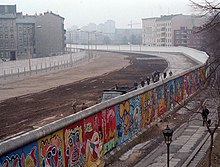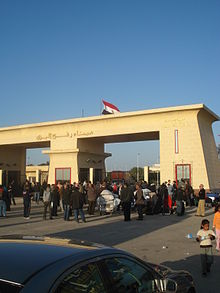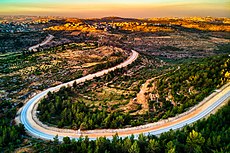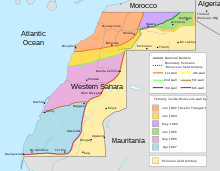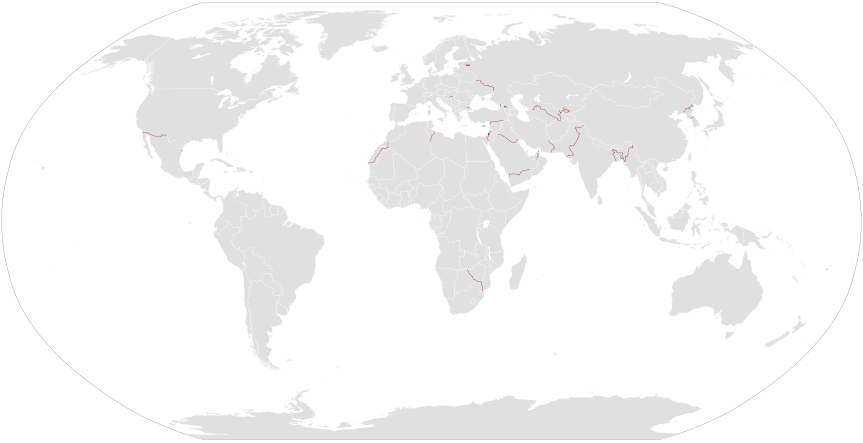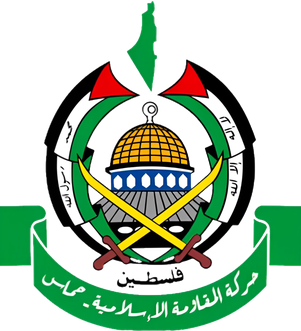
Hamas, an acronym of its official name, Harakat al-Muqawama al-Islamiya, is a Palestinian Sunni Islamist political and military movement governing parts of the occupied Gaza Strip.

The Israeli–Palestinian conflict, is an ongoing military and political conflict about self-determination within the territory of the former Mandatory Palestine. Key aspects of the conflict include the Israeli occupation of the West Bank and Gaza Strip, the status of Jerusalem, Israeli settlements, borders, security, water rights, Palestinian freedom of movement, and the Palestinian right of return.

The Palestinian territories are the two regions of the former British Mandate for Palestine that have been occupied by Israel since the Six-Day War of 1967, namely the West Bank and the Gaza Strip. The International Court of Justice (ICJ) has referred to the West Bank, including East Jerusalem, as "the Occupied Palestinian Territory", and this term was used as the legal definition by the ICJ in its advisory opinion of July 2004. The term occupied Palestinian territory was used by the United Nations and other international organizations between October 1999 and December 2012 to refer to areas controlled by the Palestinian National Authority, but from 2012, when Palestine was admitted as one of its non-member observer states, the United Nations started using exclusively the name State of Palestine. The European Union (EU) also uses the term "occupied Palestinian territory". The government of Israel and its supporters use the label "disputed territories" instead.

The Israeli West Bank barrier, comprising the West Bank Wall and the West Bank fence, is a separation barrier built by Israel along the Green Line and inside parts of the West Bank. Israel describes the wall as a necessary security barrier against Palestinian political violence; whereas Palestinians describe it as an element of racial segregation and a representation of Israeli apartheid, who often call it "Wall of Apartheid". At a total length of 708 kilometres (440 mi) upon completion, the route traced by the barrier is more than double the length of the Green Line, with 15% of its length running along the Green Line or inside Israel, and the remaining 85% running as much as 18 kilometres (11 mi) inside the West Bank, effectively isolating about 9% of the land and approximately 25,000 Palestinians from the rest of the Palestinian territory.

The Gaza–Israel barrier is a border barrier located on the Israeli side of the Gaza–Israel border. The Erez Crossing, in the north of the Gaza Strip, is the only crossing point for people and goods coming from Israel into the Gaza Strip; there exists a second crossing point in the barrier, called the Kerem Shalom border crossing, which is exclusive for the crossing of goods coming from Egypt, as Israel does not allow goods to go directly from Egypt into Gaza through the Egypt–Gaza border.

The Philadelphi Corridor, also called Philadelphi Route or Saladin Axis, is the Israeli code name for a narrow strip of land, 14 km in length, situated along the entirety of the border between Gaza Strip and Egypt.
The International law bearing on issues of Arab–Israeli conflict, which became a major arena of regional and international tension since the birth of Israel in 1948, resulting in several disputes between a number of Arab countries and Israel.
The Green Line, (pre-)1967 border, or 1949 Armistice border is the demarcation line set out in the 1949 Armistice Agreements between the armies of Israel and those of its neighbors after the 1948 Arab–Israeli War. It served as the de facto borders of the State of Israel from 1949 until the Six-Day War in 1967, and continues to represent Israel’s internationally recognized borders with the two Palestinian territories: the West Bank and the Gaza Strip.

"Wall of Shame" is a phrase that is most commonly associated with the Berlin Wall. In this context, the phrase was coined by Willy Brandt, and it was used by the government of West Berlin, and later popularized in the English-speaking world and elsewhere from the beginning of the 1960s. Inspired by its usage in reference to the Berlin Wall, the term has later been used more widely.
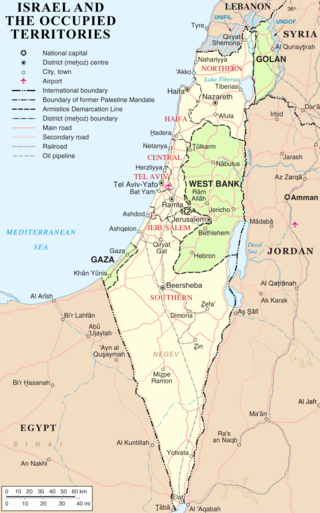
Israel has occupied the Palestinian territories and the Golan Heights since the Six-Day War of 1967. It previously occupied the Sinai Peninsula and southern Lebanon as well. Prior to Israel's victory in the Six-Day War, occupation of the Palestinian territories was split between Egypt and Jordan, with the former having occupied the Gaza Strip and the latter having annexed the West Bank; the Sinai Peninsula and the Golan Heights were under the sovereignty of Egypt and Syria, respectively. The first conjoined usage of the terms "occupied" and "territories" with regard to Israel was in United Nations Security Council Resolution 242, which was drafted in the aftermath of the Six-Day War and called for: "the establishment of a just and lasting peace in the Middle East" to be achieved by "the application of both the following principles: ... Withdrawal of Israeli armed forces from territories occupied in the recent conflict ... Termination of all claims or states of belligerency and respect for and acknowledgment of the sovereignty, territorial integrity and political independence of every State in the area and their right to live in peace within secure and recognized boundaries free from threats or acts of force."

The Allon Plan was a political proposition that outlined potential next steps for Israel after the 1967 Arab–Israeli War. It was drafted by Israeli politician Yigal Allon following Israel's seizure of territory from Syria, Jordan, and Egypt; the Israeli military had come to occupy Syria's Golan Heights, the Jordanian-annexed West Bank and the Egyptian-occupied Gaza Strip, and Egypt's Sinai Peninsula. Allon advocated a partitioning of the West Bank between Israel and Jordan, the creation of a sovereign state for Druze in the Golan Heights, and the return of most of the Sinai Peninsula to Egypt.

The Arab–Israeli conflict is the phenomenon involving political tension, military conflicts, and other disputes between various Arab countries and Israel, which escalated during the 20th century. The roots of the Arab–Israeli conflict have been attributed to the support by Arab League member countries for the Palestinians, a fellow League member, in the ongoing Israeli–Palestinian conflict; this in turn has been attributed to the simultaneous rise of Zionism and Arab nationalism towards the end of the 19th century, though the two national movements had not clashed until the 1920s.
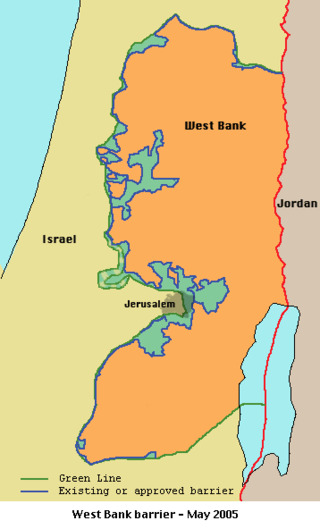
Seam Zone is a term used to refer to a land area in the Israeli-occupied West Bank located east of the Green Line and west of Israel's separation barrier, populated largely by Israelis in settlements such as Alfei Menashe, Ariel, Beit Arye, Modi'in Illit, Giv'at Ze'ev, Ma'ale Adumim, Beitar Illit and Efrat.
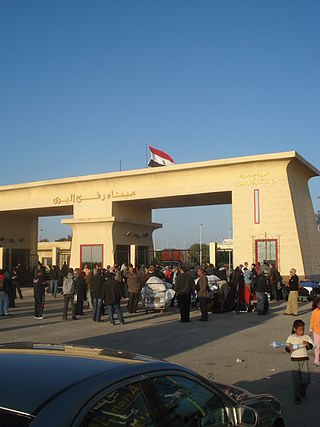
On 23 January 2008, Hamas militants in the Gaza Strip set off an explosion near the Rafah border crossing, destroying part of the 2003 wall. The United Nations estimates that as many as half the 1.5 million population of the Gaza Strip crossed the border into Egypt seeking food and supplies. Due to fears that militants would acquire weapons in Egypt, Israeli police went on increased alert.

A blockade has been imposed on the movement of goods and people in and out of the Gaza Strip following Hamas's takeover in 2007, led by Israel and supported by Egypt. The blockade's current stated aim is to prevent the smuggling of weapons into Gaza, although previously stated motivations have included exerting economic pressure on Hamas. Human rights groups have described the blockade as illegal and a form of collective punishment as it restricts the flow of essential goods, contributes to economic hardship, and limits the freedom of movement for Gaza's residents. The blockade and its effects have led to the territory being described as an "open-air prison".
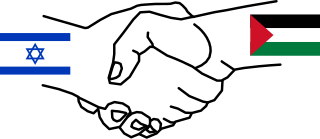
Hafrada is the policy of the government of Israel to separate the Israeli population from the Palestinian population in the occupied Palestinian territories, in both the West Bank and the Gaza Strip.

The Egypt–Gaza barrier is a steel border barrier constructed by Egypt along its 14 km border with the Gaza Strip. The Rafah border crossing is the only border crossing between the Gaza Strip and Egypt.

The Egypt–Israel barrier or Egypt–Israel border fence refers to a separation barrier built by Israel along its border with Egypt. Initial construction on the barrier began on 22 November 2010, and its original purpose as a common fence was to curb the large influx of illegal migrants from African countries into Israel. However, in the wake of the Egyptian Crisis after the 2011 Revolution, Israel's southwestern border with Egypt experienced an increase in militant jihadist activity with the outbreak of the Sinai insurgency. In response, Israel upgraded the steel barrier—called Project Hourglass by the Israel Defense Forces (IDF)—to include cameras, radars, and motion detectors. In January 2013, construction on the barrier's main section was completed; the final section was completed in December 2013.
Nakba Day in 2011 was the annual day of commemoration for the Palestinian people marking the Nakba—the displacement that accompanied the creation of Israel in 1948. Generally held on May 15, commemorative events in 2011 began on May 10, in the form of march by Palestinian Arab citizens of Israel on Israel's Independence Day. On May 13, clashes between stone-throwing youths and Israeli security forces in East Jerusalem resulted in one Palestinian fatality, and clashes continued there and in parts of the West Bank in the days following.
